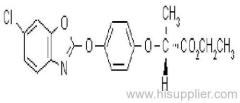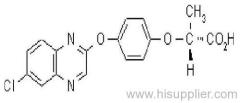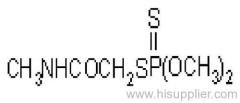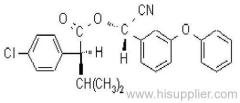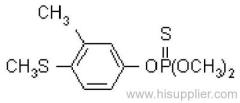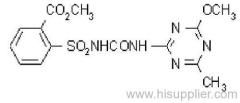
|
Shanghai Skyblue Chemical Co., Ltd.
|
Pirimiphos-Methyl
| Place of Origin: | Shanghai, China (Mainland) |
|
|
|
| Add to My Favorites | |
| HiSupplier Escrow |
Product Detail
Broad-spectrum insecticide and acaricide with contact and respiratory action. Penetrates the leaf tissue and exhibits translaminar action.
Common name: pirimiphos-methyl; pyrimiphos-méthyl
IUPAC name: O-2-diethylamino-6-methylpyrimidin-4-yl O,O-dimethyl phosphorothioate
Chemical Abstracts name: O-[2-(diethylamino)-6-methyl-4-pyrimidinyl] O,O-dimethyl phosphorothioate
CAS RN: [29232-93-7]
IUPAC name: O-2-diethylamino-6-methylpyrimidin-4-yl O,O-dimethyl phosphorothioate
Chemical Abstracts name: O-[2-(diethylamino)-6-methyl-4-pyrimidinyl] O,O-dimethyl phosphorothioate
CAS RN: [29232-93-7]
PHYSICAL CHEMISTRY
Composition: Tech. material is 90% pure. Mol. wt.: 305.3; M.f.: C11H20N3O3PS; Form: Straw-coloured liquid. M.p.: 15-18 ºC (tech.) B.p.: Decomposes on distillation. V.p.: 2 mPa (20 ºC); 6.9 mPa (30 ºC); 22 mPa (40 ºC). KOW: logP = 4.2 (20 ºC, unionised). Henry: 6x10-2 Pa m3 mol-1 (calc.) S.g./density: 1.17 (20 ºC); 1.157 (30 ºC). Solubility: In water 11 (pH 5), 10 (pH 7), 9.7 (pH 9) (all in mg/l, 20 ºC). Miscible with most organic solvents, e.g. alcohols, ketones, halogenated hydrocarbons. Stability: Hydrolysed by concentrated acids and alkalis; DT50 2-117 d (pH range 4-9, most stable at pH 7). In sunlight, aqueous solution had DT50 <1 h. pKa: 4.30; F.p.: >46 ºC.
APPLICATIONS
Biochemistry: Cholinesterase inhibitor.
Mode of action: Broad-spectrum insecticide and acaricide with contact and respiratory action. Penetrates the leaf tissue and exhibits translaminar action.
Uses: Control of a wide range of insects and mites in warehouses, stored grain, animal houses, domestic and industrial premises; chewing insects, sucking insects, boring insects, and mites on vegetables, ornamentals, bulb flowers, sugar cane, maize, sorghum, rice, citrus and other fruit, olives, vines, alfalfa, cereals, etc.; and glasshouse pests (especially whitefly, thrips, mealybugs, aphids, and mites) on tomatoes, cucumbers, capsicums, aubergines, and other glasshouse crops.
Formulation types: AE; DP; EC; FU; HN; KN; LS; SG; UL.
Compatibility: Miscible with common insecticides and fungicides. Mixing with strongly alkaline or acidic substances should be avoided.
MAMMALIAN TOXICOLOGY
Oral: Acute oral LD50 for rats 1414, mice 1180 mg/kg.
Skin and eye: Acute percutaneous LD50 for rats >2000 mg/kg. Slight eye and mild skin irritation (rabbits). Mild skin sensitiser (guinea pigs).
Inhalation: LC50 (4 h) for rats >5.04 mg/l.
NOEL: (2 y) for rats 10 mg/kg diet. No teratogenic effects, and no concentration in adipose tissue. NOEL (90 d) for dogs 0.5, rats 8 mg/kg diet.
ADI: 0.03 mg/kg b.w.
Toxicity class: WHO (a.i.) III; EPA (formulation) III
EC hazard: Xn; R22
ECOTOXICOLOGY
Birds: Acute oral LD50 for bobwhite quail 40, Japanese quail 140, mallard ducks 1695 mg/kg.
Fish: LC50 (96 h) for rainbow trout 0.64 mg/l; (48 h) for mirror carp 1.4 mg/l.
Daphnia: EC50 (48 h) 0.21 ug/l; (21 d) 0.08 ug/l.
Algae: EC50 1.0 mg/l.
Bees: Toxic to bees.
Worms: LC50 (14 d) 419 mg/kg.
Birds: Acute oral LD50 for bobwhite quail 40, Japanese quail 140, mallard ducks 1695 mg/kg.
Fish: LC50 (96 h) for rainbow trout 0.64 mg/l; (48 h) for mirror carp 1.4 mg/l.
Daphnia: EC50 (48 h) 0.21 ug/l; (21 d) 0.08 ug/l.
Algae: EC50 1.0 mg/l.
Bees: Toxic to bees.
Worms: LC50 (14 d) 419 mg/kg.
ENVIRONMENTAL FATE
Animals: In mammals, the P-O bond is cleaved extensively and N-dealkylation and/or conjugation is a further step in the metabolism of the pyrimidine leaving group.
Plants: Rapidly evaporates. After 2-3 days, <10% remains on plants, including the degradation product O-2-ethylamino-6-methylpyrimidin-4-yl O,O-dimethyl phosphorothioate. On stored cereals, DT50 >2 mo.
Soil/Environment: Soil DT50 (aerobic and anaerobic) is typically 3.5-25 d.
Related Search
Methyl Cellulose
Carboxyl Methyl Cellulose
Carboxyl Methyl Cellulose Cmc
Carboxy Methyl Cellulose Cmc
More>>




